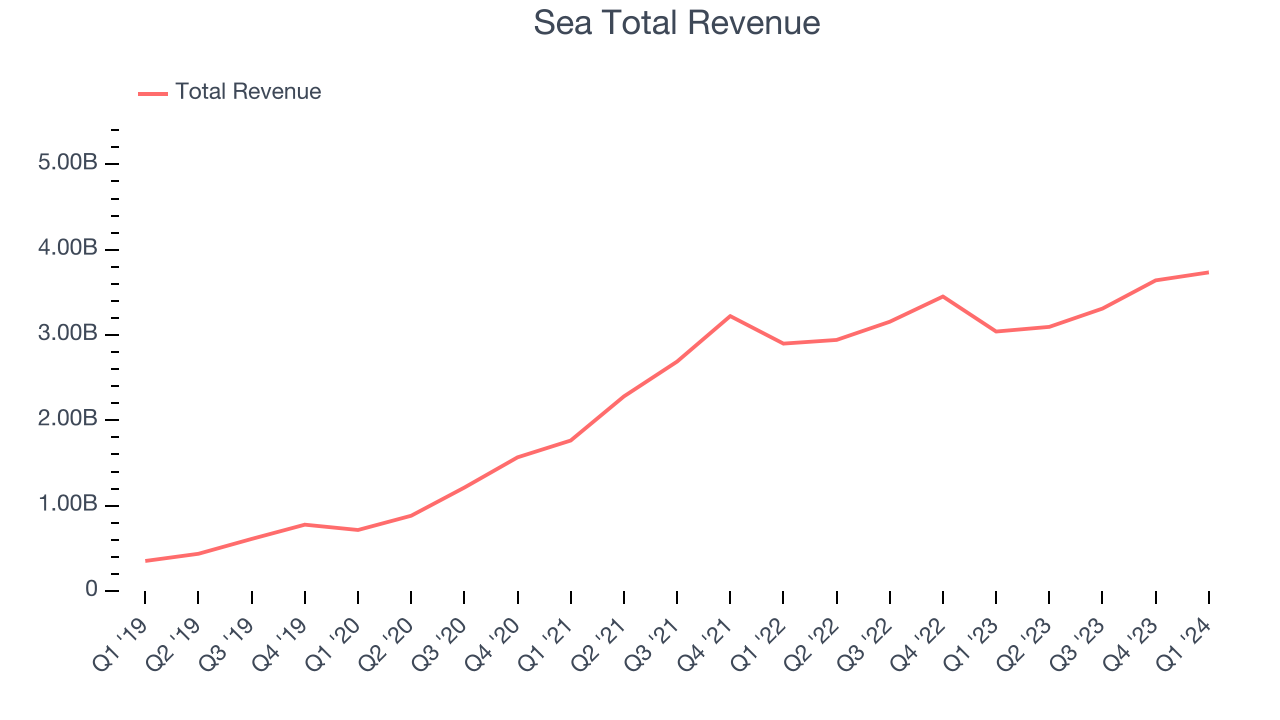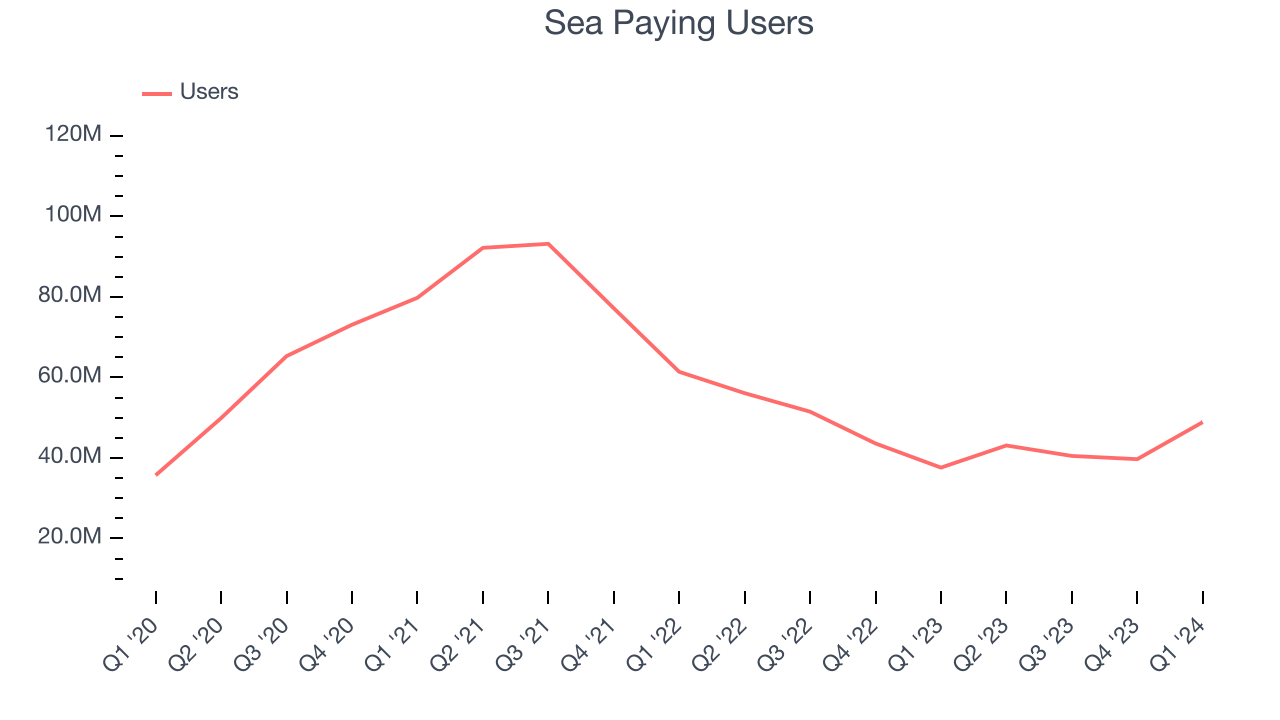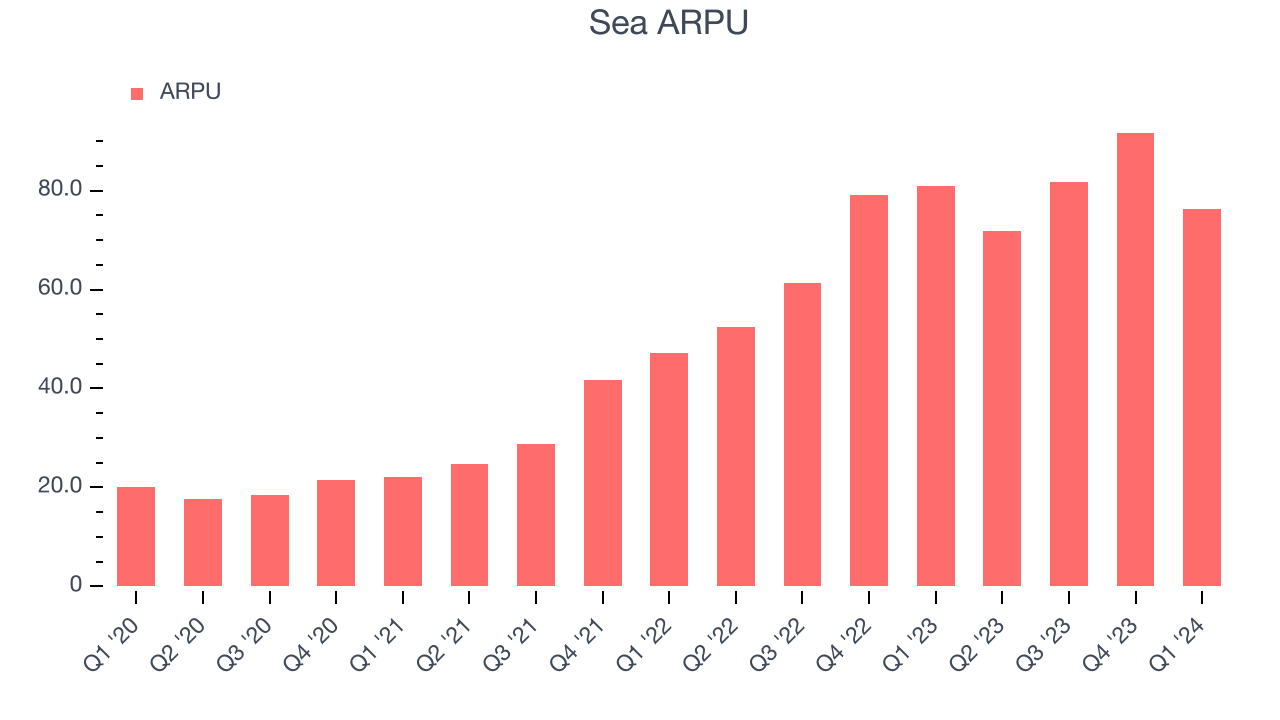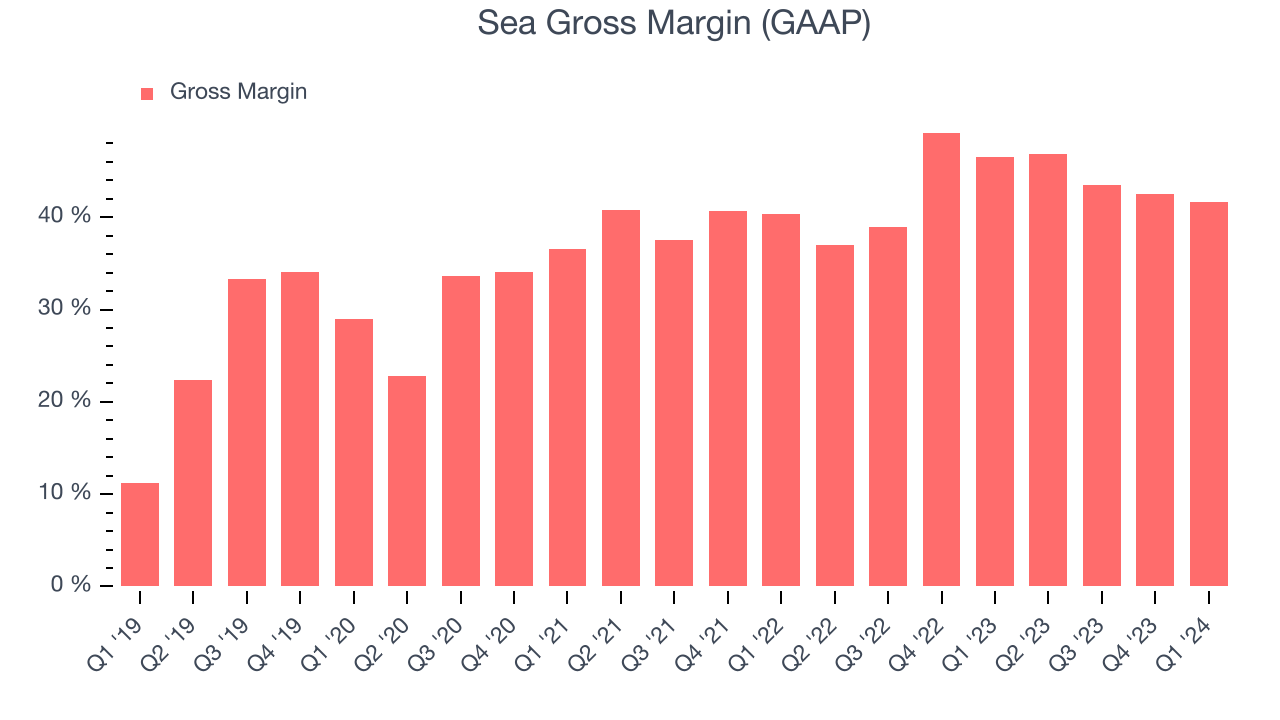E-commerce and gaming company Sea (NYSE:SE) beat analysts' expectations in Q1 CY2024, with revenue up 22.8% year on year to $3.73 billion. It made a GAAP loss of $0.04 per share, down from its profit of $0.15 per share in the same quarter last year.
Sea (SE) Q1 CY2024 Highlights:
- Revenue: $3.73 billion vs analyst estimates of $3.62 billion (3.1% beat)
- Adjusted EBITDA: $401.1 million vs analyst estimates of $227.4 million (large beat)
- EPS: -$0.04 vs analyst estimates of $0.03 (-$0.07 miss)
- Gross Margin (GAAP): 41.6%, down from 46.6% in the same quarter last year
- Paying Users: 48.9 million, up 11.3 million year on year
- E-commerce GMV (gross merchandise value): $23.6 billion vs analyst estimates of $22.5 billion (4.9% beat)
- Digital Entertainment bookings: $512.1 million vs analyst estimates of $479.7 million (6.8% beat)
- Market Capitalization: $37.02 billion
Founded in 2009 and a publicly traded company since 2017, Sea (NYSE:SE) started as a gaming platform and has since expanded to offer a variety of services such as e-commerce, digital payments, and financial services across Southeast Asia.
Garena, the initial product offering, is not just a single game but an ecosystem that allows users to play and socialize with other gamers from around the world. Whether players prefer action-packed shooters or strategy games, Garena seemingly has something for everyone, with additional features such as real-time chat to enhance engagement.
After gaming, Sea expanded into e-commerce with its Shopee platform, which is one of the largest digital marketplaces in Southeast Asia. Shopee allows users to buy and sell a wide variety of products, from electronics to groceries. Sea’s approach to e-commerce is a hybrid one–it acts as a marketplace but also holds inventory for some product categories. The company also offers financial services such as money transfers, bill payments, and pre-paid mobile phone top-ups through its SeaMoney platform.
In e-commerce, Sea generates revenue by taking a cut of the sale price when it acts as a marketplace and makes money on the actual sale price when it holds inventory. Gaming revenue primarily makes money through in-game purchases, where players can buy virtual goods such as skins, weapons, and other enhancements to improve the gaming experience.
Online Marketplace
Marketplaces have existed for centuries. Where once it was a main street in a small town or a mall in the suburbs, sellers benefitted from proximity to one another because they could draw customers by offering convenience and selection. Today, a myriad of online marketplaces fulfill that same role, aggregating large customer bases, which attracts commission-paying sellers, generating flywheel scale effects that feed back into further customer acquisition.
Competitors offering e-commerce platforms include Amazon.com (NASDAQ:AMZN) and Alibaba (NYSE:BABA), and competitors offering digital gaming include Sony (TSE:6758) and Nintendo (TSE:7974).Sales Growth
Sea's revenue growth over the last three years has been impressive, averaging 45.6% annually. This quarter, Sea beat analysts' estimates and reported decent 22.8% year-on-year revenue growth.

Ahead of the earnings results, analysts were projecting sales to grow 16.3% over the next 12 months.
Usage Growth
As an online marketplace, Sea generates revenue growth by increasing both the number of users on its platform and the average order size in dollars.
Sea has been struggling to grow its users, a key performance metric for the company. Over the last two years, its users have declined 23.7% annually to 48.9 million. This is one of the lowest rates of growth in the consumer internet sector.

Luckily, Sea added 11.3 million users in Q1, leading to 30.1% year-on-year growth.
Revenue Per User
Average revenue per user (ARPU) is a critical metric to track for consumer internet businesses like Sea because it measures how much the company earns in transaction fees from each user. Furthermore, ARPU gives us unique insights as it's a function of a user's average order size and Sea's take rate, or "cut", on each order.

Sea's ARPU growth has been exceptional over the last two years, averaging 58.2%. Although its users have shrunk during this time, the company's ability to successfully increase prices demonstrates its platform's enduring value for existing users. This quarter, ARPU declined 5.6% year on year to $76.37 per user.
Pricing Power
A company's gross profit margin has a major impact on its ability to exert pricing power, develop new products, and invest in marketing. These factors may ultimately determine the winner in a competitive market, making it a critical metric to track for the long-term investor.
Sea's gross profit margin, which tells us how much money the company gets to keep after covering the base cost of its products and services, came in at 41.6% this quarter, down 5 percentage points year on year.
For online marketplaces like Sea, these aforementioned costs typically include payment processing, hosting, and bandwidth fees in addition to the costs necessary to onboard buyers and sellers, such as identity verification. After paying for these expenses, Sea had $0.42 for every $1 in revenue to invest in marketing, talent, and the development of new products and services.

Sea's gross margins have been trending up over the last 12 months, averaging 43.5%. This is a welcome development, as Sea's margins are below the industry average, and rising margins could suggest improved demand and pricing power.
User Acquisition Efficiency
Unlike enterprise software that's typically sold by dedicated sales teams, consumer internet businesses like Sea grow from a combination of product virality, paid advertisement, and incentives.
It's relatively expensive for Sea to acquire new users as the company has spent 52.4% of its gross profit on sales and marketing expenses over the last year. This level of efficiency indicates that Sea has to compete for its users and continue investing to maintain its growth trajectory.
Key Takeaways from Sea's Q1 Results
We enjoyed seeing Sea increase its number of users this quarter as well as beats on the GMV (gross merchandise value) line for e-commerce and the bookings line for Digital Entertainment. This led to consolidated revenue and adjusted EBITDA outperformance versus Wall Street's estimates. Overall, we think this was a strong quarter that should satisfy shareholders. The stock is up 1.8% after reporting and currently trades at $65.6 per share.
Is Now The Time?
When considering an investment in Sea, investors should take into account its valuation and business qualities as well as what's happened in the latest quarter.
We think Sea is a solid business. Its revenue growth has been exceptional over the last three years, and growth is expected to increase in the short term. And while its users have declined, the good news is its top-tier ARPU growth shows the increasing value of its platform to its users. On top of that, its strong free cash flow generation allows it to invest in growth initiatives while maintaining an ample cash cushion.
At the moment, Sea trades at 33.6x next 12 months EV-to-EBITDA. There are definitely things to like about Sea and looking at the consumer internet landscape right now, it seems that it doesn't trade at an unreasonable price.
Wall Street analysts covering the company had a one-year price target of $68.68 per share right before these results (compared to the current share price of $65.60), implying they saw upside in buying Sea in the short term.
To get the best start with StockStory check out our most recent Stock picks, and then sign up to our earnings alerts by adding companies to your watchlist here. We typically have the quarterly earnings results analyzed within seconds of the data being released, and especially for the companies reporting pre-market, this often gives investors the chance to react to the results before the market has fully absorbed the information.
